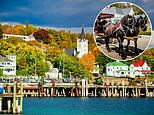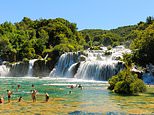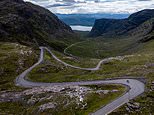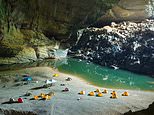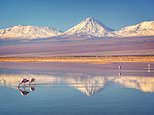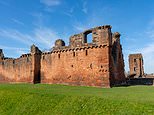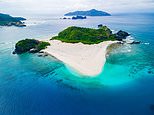EXCLUSIVEArid, remote and irresistible: Not much grows in Chile's Atacama desert - except your appreciation of its wonders
- Chile’s tourism numbers rose 84 per cent from 2022 to 2023
- Many are choosing the Atacama as one of their stops there
- Charlotte Lytton explores the world's driest non-polar desert to find out why
- While there she tries barbecued alpaca and visits the mysterious Moon Valley
- READ MORE: Eight breathtaking European castles you can sleep in
The Atacama is the world’s driest non-polar desert – a landscape so vast and arid that Nasa practices Mars expeditions there.
So when a carpet of purple flowers began poking through the earth in October 2022, Chile’s president Gabriel Boric Font declared the diverse area a national park, giving it the most protected status the country offers.
Brightly coloured blooms aren’t exactly what you’d expect somewhere like this. But there are more than 200 flower species in the Atacama – a 105,000km sq expanse that turns out to be flecked with every shade.
I fly into Calama, the nearest airport, amid an orange-streaked night sky, and over the days that follow I find that the bronze is regularly broken by a pop of lush green grass or a cobalt lagoon.
Guanacos, native wild camelids known as the ‘gardeners’ of this flowering desert, nibble away, while tagua cornudas (or horned coots) squabble in the water. Peaches, lemons and oranges grow here, sweetened by minerals in the soil.

Charlotte Lytton explores Chile's Atacama, the world’s driest non-polar desert – a landscape so vast and arid that Nasa practices Mars expeditions there

Charlotte begins her adventure at Laguna Chaxa (pictured above) where flamingos pick through the water in near-silence
Chile’s tourism numbers have been growing fast, rising 84 per cent from 2022 to 2023 – with many choosing to make this stop in the country’s north.
There are excursions ranging from walking along rocky valleys to watching the sun rise over hot springs, and a dip in a lagoon so buoyant that you bob atop the water.
We begin our own pick ‘n’ mix adventure at Laguna Chaxa where, on a bright morning, flamingos pick through the water in near-silence. There are three kinds of flamingo flourishing here – the James’s, Andean and Chilean (the latter are distinct for their hot‑pink tails). They are circled by passing vicunas, another camelid, whose numbers are growing thanks to ultra-remote conditions.
Reaching each corner of this desert requires a fair amount of time on the road, with the bumps significantly improved by drivers and guides from the regions.
Andante Travels provides tours in conjunction with Tours by Locals – which they really are.

Charlotte notes that there are three kinds of flamingo in the area – the James’s, Andean and Chilean. Above are two birds of the Chilean variety

Pictured here is Terrantai Lodge, a boutique hotel in the middle of San Pedro (Atacama’s main town)
We take a pit stop in the little town of Machuca, where our guide knows – and introduces us to – everyone we meet by name, urging us to try the local goat’s cheese empanada (delicious) and barbecued alpaca (chewy).
The uber-dry climate also makes Atacama a wine haven, with the Carmenere top pick for a full-bodied red.
At Terrantai Lodge, a boutique hotel in the middle of San Pedro (Atacama’s main town), you can put all of the local wines to the test with nightly organic tastings, set within its beautiful courtyard.
With Chile among the world’s finest wine producers, trying them here is simply due diligence.
If you enjoy a glass (or several) of an evening, watch out for the altitude: the Cerro Toco hike reaches an 18,386 ft summit on a trail where breathing is more challenging than walking. But if you would rather go slow, there’s also plenty of flat ground to explore.
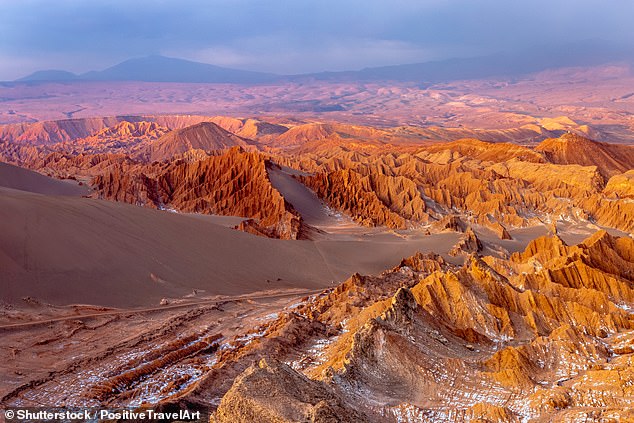
Moon Valley, seen here, 'provides the region’s most picture-perfect desert snapshot'

Charlotte visits the Tatio geysers (above), where she witnesses white puffs of steam shooting upwards
The Moon Valley provides the region’s most picture-perfect desert snapshot – there are golden dunes and sloping rock formations carved out by the wind and water, with part of the area covered in bright white salt.
White puffs shoot up on a sunrise trip to the Tatio geysers, too – the cold air illuminating steam from the hot springs as they blow.
The 4am drive hurts, of course, but a coffee at the end, with the spectacular Andes mountain range in view, makes the pre-dawn start well worth it.
Things had already begun well when we reached Ojos del Salar, a mini-lagoon where blue sky and fluffy clouds were perfectly mirrored in the still water.
Later, a short drive, followed by a walk through tall green fields, brought us to Laguna Cejar – an easy favourite for minimum effort and maximum buoyancy, where the super-high salt content bounces you atop the water. Like so much of the Atacama, it’s incredibly remote, and peaceful – the only sounds you’ll hear are bursts of laughter from those attempting to swim while bobbing up and down in the lagoon. It feels only right to see off the afternoon with a pisco sour as the sun sets over this unique corner of the planet.
As we sip, our guide tells us of an emerging scientific theory: that the origin of all life can be found right here in the Atacama. With tamarugo trees towering above the scorched ground, and viscachas – rabbit-like animals with huge whiskers – skittering past, perhaps that doesn’t seem so far-fetched.

Charlotte says 'peaceful' Laguna Cejar, seen here, is an 'easy favourite for minimum effort and maximum buoyancy, where the super-high salt content bounces you atop the water'
























































































